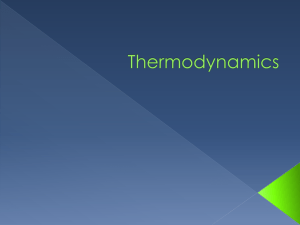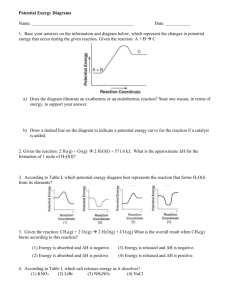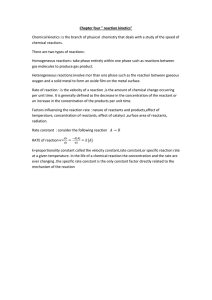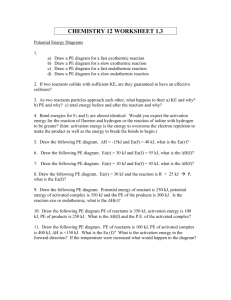Entropy and Gibbs free energy
advertisement
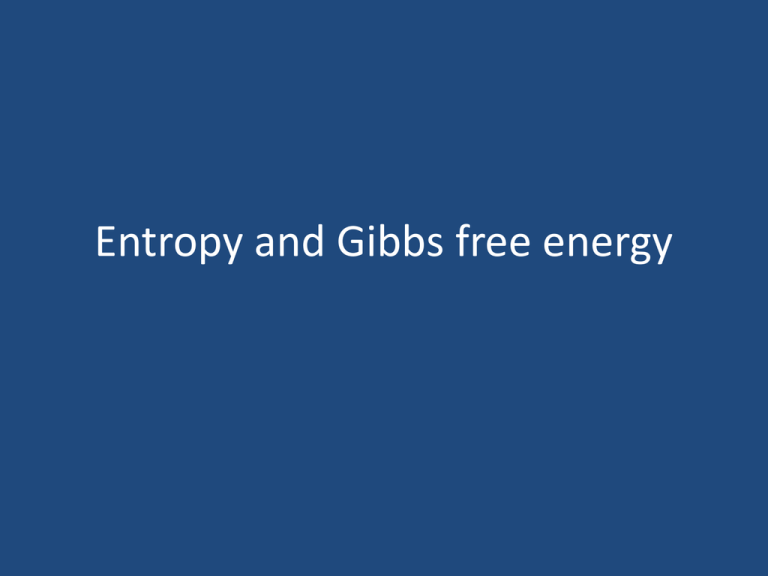
Entropy and Gibbs free energy Exothermic • The products are lower in energy than the reactants • Releases energy • Often release heat 2 Energy C + O2 CO2 + 395 kJ C + O2 -395kJ CO2 Reactants 3 Products When will a reaction be exothermic A) When breaking the bonds of the reactants takes more energy than making the bonds of the products. B) When breaking the bonds of the reactants takes less energy than making the bonds of the products C) When you put in energy to break the bonds D) When you get energy by breaking bonds Endothermic • The products are higher in energy than the reactants • Absorbs energy • Absorb heat 5 CaCOCaCO kJ CaO CaO + 2CO2 + CO 3 + 176 3 Energy CaO + CO2 +176 kJ CaCO3 Reactants 6 Products Heat of Reaction • The heat that is released or absorbed in a chemical reaction • Equivalent to ΔH • C + O2(g) CO2(g) +393.5 kJ • C + O2(g) CO2(g) ΔH = -393.5 kJ • In thermochemical equation it is important to say what state • H2(g) + ½ O2 (g) H2O(g) ΔH = -241.8 kJ • H2(g) + ½ O2 (g) H2O(l) ΔH = -285.8 kJ 7 Energy Change is down ΔH is <0 Reactants 8 Products + heat Energy Change is up ΔH is > 0 Reactants + heat Reactants 9 Products Choose all that apply... C(s) + 2 S(g) CS2(l) ΔH = 89.3 kJ Which of the following are true? A) This reaction is exothermic B) It could also be written C(s) + 2 S(g) + 89.3 kJ CS2(l) C) The products have higher energy than the reactants D) It would make the water in the calorimeter colder Heat of Combustion • The heat from the reaction that completely burns 1 mole of a substance at 25°C and 1 atm • C2H4 + 3 O2 2 CO2 + 2 H2O • C2H6 + O2 CO2 + H2O • 2 C2H6 + 7 O2 4 CO2 + 6 H2O • C2H6 + (7/2) O2 2 CO2 + 3 H2O • Always exothermic 11 Heat and phase change • Melting and vaporizing are endothermic – Breaking things apart • Freezing and condensing are exothermic – Forming connections Heat of Fusion • • • • • Heat of fusion-ΔHfus- heat to melt one gram q = ΔHfus x m For water 80 cal/g or 334 J/g Same as heat of solidification Book uses molar heat of fusion- heat to melt one mole of solid • q = ΔHfus x n Calculating Heat • If there is a temperature change – q = m ΔT C • If there is a phase change – q = ΔHfus x m or – q = ΔHvap x m or q = ΔHsolid x m q = ΔHcond x m • If there is both, do them separately and add. Example • Ammonia has a heat of fusion of 332 cal/g. How much heat to melt 15 g of ammonia? This formula is for all change • ΔH = ΣΔH°f (products) - ΣΔΗ°f(reactants) H = H (products) - H (reactants ) o f o f Example • CH4(g) + 2 O2(g) CO2(g) + 2 H2O(g) H H H H o f o f o f o f CH4 (g) = -74.86 kJ O2(g) = 0 kJ CO2(g) = -393.5 kJ H2O(g) = -241.8 kJ ΔH= [-393.5 kJ + 2(-241.8 kJ)] - [-74.86 kJ +2 (0 kJ )] ΔH= -802.2 kJ 17 Energy elements H o f ( reactants) H o f ( products) reactants products H o f ( products) Reactants H o f ( reactants) exothermic Products Energy elements H o f ( reactants) H products o f ( products) reactants H o f ( reactants) Reactants H o f ( products)endothermic Products Energy Reactants Products Reaction coordinate Energy Activation Energy Minimum energy to make the reaction happen – how hard Reactants Products Reaction coordinate Energy Activated Complex or Transition State Reactants Products Reaction coordinate Activation Energy • Must be supplied to start the reaction • Low activation energy – Lots of collision are hard enough – fast reaction • High Activation energy – Few collisions hard enough – Slow reaction Energy Reactants Products Reaction coordinate Energy Activation Energy Minimum energy to make the reaction happen – how hard Reactants Products Reaction coordinate Energy Activated Complex or Transition State Reactants Products Reaction coordinate Activation Energy • Must be supplied to start the reaction • Low activation energy – Lots of collision are hard enough – fast reaction • High Activation energy – Few collisions hard enough – Slow reaction Activation energy • If reaction is endothermic you must keep supplying heat • If it is exothermic it releases energy • That energy can be used to supply the activation energy to those that follow Energy Reactants Overall energy change Products Reaction coordinate Thermodynamics Will a reaction happen? Things that Affect Rate • Catalysts- substances that increase the rate of a reaction without being used up.(enzyme). • Not a reactant nor a product. • Speeds up reaction by giving the reaction a new path. • The new path has a lower activation energy. • More molecules have this energy. • The reaction goes faster. Energy Reactants Products Reaction coordinate Catalysts H H • Hydrogen bonds to surface of metal. • Break H-H bonds H H Pt surface H H H H Catalysts H H H C C H H H H H Pt surface Catalysts • The double bond breaks and bonds to the catalyst. H H H C H C H H Pt surface H H Catalysts • The hydrogen atoms bond with the carbon H H H C H C H H Pt surface H H Catalysts H H H H C C H H H Pt surface H Energy • Substances tend react to achieve the lowest energy state. • Most chemical reactions are exothermic. • Doesn’t work for things like ice melting. • An ice cube must absorb heat to melt, but it melts anyway. Why? Entropy • The degree of randomness or disorder. • Better – number of ways things can be arranged • S • The First Law of Thermodynamics - The energy of the universe is constant. • The Second Law of Thermodynamics -The entropy of the universe increases in any change. • Drop a box of marbles. • Watch your room for a week. Entropy Entropy of a solid Entropy of a liquid Entropy of a gas • A solid has an orderly arrangement. • A liquid has the molecules next to each other but isn’t orderly • A gas has molecules moving all over the place. Entropy increases when... • Reactions of solids produce gases or liquids, or liquids produce gases. • A substance is divided into parts -so reactions with more products than reactants have an increase in entropy. • The temperature is raised -because the random motion of the molecules is increased. • a substance is dissolved. Entropy calculations • There are tables of standard entropy (pg 407). • Standard entropy is the entropy at 25ºC and 1 atm pressure. • Abbreviated Sº, measure in J/K. • The change in entropy for a reaction is • ΔSº= ΣSº(Products)-ΣSº(Reactants). • Calculate ΔSº for this reaction • CH4(g) + 2 O2(g) CO2(g) + 2 H2O(g) • • • • • • Calculate ΔSº for this reaction CH4(g) + 2 O2(g) CO2(g) + 2 H2O(g) For CH4 Sº = 186.2 J/K-mol For O2 Sº = 205.0 J/K-mol For CO2 Sº= 213.6 J/K-mol For H2O(g) Sº = 188.7 J/K-mol Spontaneity Will the reaction happen, and how can we make it? Spontaneous reaction • • • • • Reactions that will happen. Nonspontaneous reactions don’t. Even if they do happen, we can’t say how fast. Two factors influence. Enthalpy (heat) and entropy(disorder). Two Factors • Exothermic reactions tend to be spontaneous. – Negative H. • Reactions where the entropy of the products is greater than reactants tend to be spontaneous. – Positive ΔS. • A change with positive ΔS and negative ΔH is always spontaneous. • A change with negative ΔS and positive ΔH is never spontaneous. Gibbs Free Energy • The energy free to do work is the change in Gibbs free energy. • ΔGº = ΔHº - TΔSº (T must be in Kelvin) • All spontaneous reactions release free energy. • So ΔG <0 for a spontaneous reaction. ΔG is negative Problems • Using the information on page 407 and pg 190 determine if the following changes are spontaneous at 25ºC. • 2H2S(g) + O2(g) 2H2O(l) + S(rhombic) 2H2S(g) + O2(g) 2H2O(l) + 2S • We find ΔHf° for each component – H2S = -20.1 kJ – H2O = -285.8 kJ O2 = 0 kJ S = 0 kJ • Then Products – Reactants • ΔH =2 (-285.8 kJ) + 2(0 kJ) - 2 (-20.1 kJ) - 1(0 kJ) = -531.4 kJ 2H2S(g) + O2(g) 2H2O(l) + 2 S • we find S for each component – H2S = 205.6 J/K – H2O = 69.94 J/K O2 = 205.0 J/K S = 31.9 J/K • Then Products – Reactants • ΔS= 2 (69.94 J/K) + 2(31.9 J/K) - 2(205.6 J/K) - 205 J/K = -412.5 J/K 2H2S(g) + O2(g) 2H2O(l) + 2 S • • • • • • • • ΔG = ΔH – T ΔS G = -531.4 kJ - 298K (-412.5 J/K) G = -531.4 kJ - -123000 J ΔG = -531.4 kJ - -123 kJ ΔG = -408.4 kJ Spontaneous Exergonic- it releases free energy. At what temperature does it become spontaneous? Spontaneous • • • • • It becomes spontaneous when ΔG = 0 That’s where it changes from positive to negative. Using 0 = ΔH – T ΔS and solving for T 0 - ΔH = - T ΔS - ΔH = -T ΔS • T = ΔH = -531.4 kJ = -531400 J = 1290 K ΔS -412.5 J/K -412.5 J/K There’s Another Way • There are tables of standard free energies of formation compounds.(pg 414) • ΔGºf is the free energy change in making a compound from its elements at 25º C and 1 atm. • for an element ΔGºf = 0 • Look them up. • ΔGº= ΔGºf(products) - ΔGºf(reactants) 2H2S(g) + O2(g) 2H2O(l) + 2S • From we find ΔGf° for each component – H2S = -33.02 kJ – H2O = -237.2 kJ O2 = 0 kJ S = 0 kJ • Then Products – Reactants • ΔG =2 (-237.2) + 2(0) - 2 (-33.02) - 1(0) = -408.4 kJ
